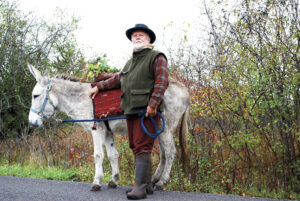walkingwiththunder.com
The thing about carrots

By Conrad Beaubien
I have never quite perceived the idea that carrots would one day serve as a unifier. Sure we rush to the seed catalogues and we plant varieties in spring and care for them in our gardens all summer long and then comes the harvest and delight with the kitchen part and the likely bonus of sharing with our neighbours. Back in September I came across a small, carefully built produce stand set out in front of a residence in one of Picton’s historic neighbourhoods. Set out were tomatoes and beans and cucumbers and more tomatoes and, of course, bright orange carrots. The owners had tacked up a small sign that described a pay what-youcan system and that the food was grown in the family’s backyard garden for relief and peace of mind while staying within their isolation bubble during our time of coronavirus. It was also mentioned that proceeds from the veggies were going to the gardeners’ favourite local charity. Here was a circle turning for broad benefit.
Carrots also prompt a personal recall that apparently my age group grew up in the Carotene era. During my earlier days I could never quite figure out the process of a vision test for rabbits, because we were simply told to eat carrots as they were good for eyesight. Take rabbits for example, they would say. Frankly, I took to believing that rabbits were held captive until everyone was certain they could at least read the E, FP, TOZ lines on the eye chart before they were freed to see their way home.
 My carotene related epiphany moment came when I discovered that carrots, when shredded could be blended with coconut oil, dark brown sugar, flour, egg, heavy cream, a touch of baking powder, the mix then baked in the oven for sixty minutes. While this took place, you could toss cream cheese in a bowl with added cream cheese frosting; then as soon as the resulting carrot cake came out of the oven you could layer on that finest topping. To my amazement, the carrot cake still hung in under the category of carotene intake; man, did I love Madam Jehane Benoît, Francophone kitchen queen of the era and how she would say le carrotte! I vowed to Madam, who was right before me on the television screen that day, that I would undertake herculean effort to better my vision to the point that I could spot mineral deposits in the Rocky Mountains from exactly where I stood along the banks of the Ottawa River. From then on, carrots have decidedly been a keeper on my menu choices and over the years I’ve tasted my way through carrot soup, roasted carrots, carrot muffins and golden Shepherd’s pie. Looking back, I reckon it also must have been the Carotene age that came up with jellied carrot salad as the signature dish of church suppers.
My carotene related epiphany moment came when I discovered that carrots, when shredded could be blended with coconut oil, dark brown sugar, flour, egg, heavy cream, a touch of baking powder, the mix then baked in the oven for sixty minutes. While this took place, you could toss cream cheese in a bowl with added cream cheese frosting; then as soon as the resulting carrot cake came out of the oven you could layer on that finest topping. To my amazement, the carrot cake still hung in under the category of carotene intake; man, did I love Madam Jehane Benoît, Francophone kitchen queen of the era and how she would say le carrotte! I vowed to Madam, who was right before me on the television screen that day, that I would undertake herculean effort to better my vision to the point that I could spot mineral deposits in the Rocky Mountains from exactly where I stood along the banks of the Ottawa River. From then on, carrots have decidedly been a keeper on my menu choices and over the years I’ve tasted my way through carrot soup, roasted carrots, carrot muffins and golden Shepherd’s pie. Looking back, I reckon it also must have been the Carotene age that came up with jellied carrot salad as the signature dish of church suppers.
The veg is a tap root, a wild carrot that has evolved through the millennia growing and seeding up and down the well travelled trade route of the east, the Silk Road. It was Apicius Cyclius, an apparent celebrity chef of ancient Rome who had a bestseller on his hands when his ‘cookery’ book glorified the taste and benefits of Karota. Today the Carrot Field of Iran is a heralded link to the earliest story of the lineage of carrots as a storage crop, one of our favourite winter crops.
So all this about carrots comes around to my habit of the day of travelling with carrots sitting on the front seat of my truck seemingly 24/7. The pattern goes hand in hand with my befriending a small family of equine animals—three members to be exact; the donkeys Thunder and Joe and the Norwegian horse Micah. I have written recently of my personal isolation medicine of spending time outdoors with these guys as often as I can and in all weather. It’s an important step in a project I am giving rise to called Walking with Thunder. It’s about harnessing—no pun intended— the calm and peace of mind that animals can offer us, especially when surrounded by nature all around. My aim is to discover ways that this prescription can be shared to help combat the effects of isolation, a pandemic in its own right with symptoms of loneliness and depression.
Turns out that carrots come in almost every color in the spectrum, something made evident with the return to growing heritage varieties. Purple, yellow, red, black and white carrots now favour many a table top: Little Horn, Dutch Hoorn (after a town in Holland), Early half long, English Horn and Half Long Davers are on current lists in your favourite seed catalogue.
Where the carrots really play out in this story is more along the line of a host or hostess gift, so that when I arrive on the farm and descend the path, past 35 chickens and 85 alpacas, one lama and a barking dog, I arrive at the gate of the lower paddock with a bouquet of carrots in hand, preferable with the greens still attached. Recently on one of visits after the meet and greets and carrots were done I simply strolled through the paddock. It was heartfelt that everyone followed without halters to lead. So it was not just about carrots. We were simply in the company of each other, unplugged from the noise of the world.
Upon leaving it was also heartfelt to look back and see Thunder and Joe at the closest corner of the paddock watching me go. Animals understand isolation and also the warmth and need of companionship, something also inherent in the nature of all of us.

Comments (0)